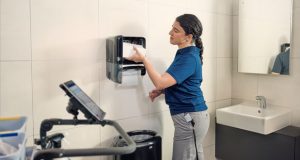 By Dr. Colm Moore – Area technical manager for Initial Washroom Hygiene
By Dr. Colm Moore – Area technical manager for Initial Washroom Hygiene
With thousands of passengers travelling to hundreds of different countries every day, Airports pose a significant challenge for hygiene management. Air travel has no doubt revolutionised the way in which the world works, helping to transport people cross continents to do business, spend vacations and visit families in mere hours. However, the speed and ease of air travel also means that airports can become significant vectors of disease and viral infection. Passengers may unknowingly be hosting dangerous microbes on their hands, clothes or luggage, allowing bugs to travel from Australia to the UK in less than 24-hours.
Health and sanitation aspects of international traffic have been of concern to the World Health Organisation (WHO) since 1951, when the Fourth World Health Assembly recommended that all governments should “improve sanitary and environmental conditions, especially in and around ports and airports.” While airport hygiene practices have remained relatively the same since their inception, the number of passengers travelling by air has grown by an order of magnitude, more than doubling since just 2004. The continuous growth of air travel has increased the likelihood of cross-border disease transmission. In the past, outbreaks such as SARS in 2003, Swine Flu in 2009, and the 2013-2019 Ebola have shown how air travel can pose the risk of elevating local epidemical outbreaks to global pandemics. While airplanes precluded facilities managers from being able to contain these outbreaks, airports exacerbated the situation by providing a point at which the healthy and the sick can converge.
This challenge is compounded by the added pressure of ensuring the flow of foot-traffic in areas such as airport and passport security, as huge volumes of passengers need to be processed in a narrow space of time. While toilets can be temporarily closed for maintenance and lobby areas can be cordoned off to clean up a spill, airport security can suffer huge disruption from the smallest interruption of service, which as a recent study has shown, has led to poorer levels of hygiene in high-traffic airport areas.
Germ hotspots
The study, conducted by The University of Nottingham and The Finnish National Institute for Health and Welfare, looked into hygiene risk hotspots in airports. Notably in airport security, the plastic trays – those which are used to ferry carry-on baggage and other small items through X-Ray machines – were found to be harbouring traces of Rhinovirus (source of the common cold) as well as the Influenza A virus. Bacteria survives best on hard, non-porous surfaces, meaning these plastic trays provide an ideal environment for microbes to survive. As the scientists who conducted the study explain, “these boxes typically cycle with high frequency to subsequent passengers and are typically seized with a wide palm surface area and strong grip,” enabling microbes to easily transfer from passenger to passenger.
As part of a wider study into airport hygiene conducted at Helsinki-Vantaa Airport in Finland, scientists swab-tested a series of common touch points, finding traces of harmful viruses on items such as payment keypads, divider glass at passport control and even toys in the children’s play-area. Traces of airborne respiratory viruses were also found in high-density areas of the airport, with the Adeno virus appearing in 1 out of 4 of the samples taken.
Ensuring standards of cleanliness and hygiene is as much, if not more, important to delivering a high standard of customer service as speed and efficiency. However, airport facilities managers need not be faced with trading-off one for the other.
By providing passengers with hand sanitising stations either at the entrance, in the queue or before the X-Ray machines can prevent pathogens from being spread via the hand and onto security trays, without adding another layer to airport security which may cause disruption to service. These handwashing signs should be clearly signposted, with eye-catching cautionary messages to remind passengers of the importance of hand hygiene in this area. Passengers will also speak a diverse range of languages, so well-worded and well-translated signs encouraging hygiene procedures are a must.
Hygiene practice in and out of the washroom
Interestingly, the joint British-Finnish airport study found no trace of harmful pathogens on common touch points in airport toilets; on toilet seats, door handles and flush levers. This finding demonstrates the power both of hygiene awareness and hygiene tools. Already in washrooms, a number of touch-free solutions are available, such as motion-activated toilet flushing buttons and soap dispensers, while passengers will have learned from a young age to pay attention to high-risk areas in the washroom. It is imperative that this awareness and these tools are transferred to other high-contact frequency touchpoints in other areas of the airport, which, as the study has shown, can be more dangerous than any surface found in a washroom.
With that being said, washroom hygiene must still remain a high-priority for cleaning staff at the airport. Toilets and washroom areas must be cleaned routinely, ensuring that perishable items such as soap and paper towels are regularly re-stocked. In addition, in order to provide a comfortable and hygienic experience for female washroom visitors, each cubicle must be fitted with facilities to dispose of feminine hygiene products. Available in a range of styles, including manual, pedal, and automatic, these bins should sit neatly beside the toilet.
Where waste disposal units are required, it’s essential that collected waste can be disposed of both hygienically and sustainably. Initial offers a feminine hygiene waste disposal service that helps businesses dispose of sanitary waste in a secure, sensitive and environmentally friendly way. More importantly, our approach to waste disposal ensures that businesses are fully compliant with UK regulations. We dispatch fully trained customer delivery representatives from one of our 17 local waste transfer stations to service a variety of premises. These visits are scheduled in advance and are performed regularly to guarantee both a consistent and hygienic approach; this involves exchanging or emptying feminine hygiene sanitary bins on each visit. Waste disposal should be a highly controlled and hygienic business, and regularly servicing the units helps to ensure and maintain a high level of hygiene within washrooms.
Towards a touch-free airport experience
As mentioned above, pretty much any surface that comes into contact with travellers can become a potential germ hotspot. With passenger numbers still growing, airport facilities managers have a vested interest in investing in new technologies which can help eliminate touchpoints along the passenger’s trajectory from entrance to gate. Already, biometric passport gates have become a welcome addition in airports for both passengers and the airports themselves, helping to cut both the time and staff required for passport security. A less recognised bonus, however, is the fact that the only contact which occurs when crossing the gate is between the inside page of a passport and the reader, rather than the more germ-prone outside being exchanged between hands. It is therefore imperative – not only for customer experience, but for passenger health also – that biometric passport security gates are maintained and kept open.
With contactless payments, the iPhone’s Face ID, and voice-pattern security being used by certain online banks, the world is undergoing something of a zero-touch revolution. In somewhat of a backwards step, airports have become reliant on self-service kiosks to speed-up check-in, baggage drop, and flight transfers. While cost-efficient, the hard surface of kiosk screens can be a breeding ground for germs, necessitating an inconvenient and costly process of disinfection after each use. Nowadays, forward-looking airports are investing in a mixture of smartphone integration and facial-recognition technologies for check-in, providing a zero-touch experience during the entire customer journey. These innovative solutions not only enhance and digitalise the all-important customer experience, but also helps to protect the health and wellbeing of passengers.
The importance of airport hygiene
To protect public health, the application of high standards of hygiene should form an integral part of airport and aircraft operations. High numbers of passengers crossed with high numbers of potential touch points combine to present a unique challenge for hygiene, especially serious in the context of air travel where local disease outbreaks can quickly elevate to epidemical levels. In the wake of the recent Ebola outbreak, where infected individuals unaware of their condition managed to spread the disease from Central Africa to the UK and USA.
However, for every hygiene problem, there is an innovative solution on offer to help airport facilities managers ensure passengers enjoy a comfortable, clean and safe customer experience. Having the correct tools – i.e. hand sanitising stations, zero-touch facilities and waste disposal units – as well as having the right practices in place – i.e. 24/7 cleaning schedules, special attention paid to high-frequency touchpoints, and staff well versed in their roles – will ensure that airport facilities managers need not suffer the stress nor anxiety of looking after the hundreds and thousands of passengers that pass through each day.





